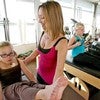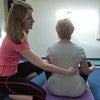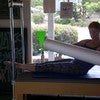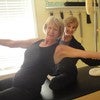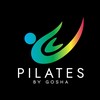Description
Dawn-Marie Ickes is here to give you your daily dose of what your body needs, emphasizing form over force. The dose is five to 15 minutes of movements performed every day that are essential to your body's health, posture, and function. In this tutorial, explore in-depth, the Roll-down, Swan Prep, Spine Stretch Forward, Butterfly, and lumbo-pelvic stabilization.
What You'll Need: Mat, Overball, Reformer Box
About This Video
(Pace N/A)
Sep 14, 2014
(Log In to track)
Comments
Skip to Latest
Really enjoyed this. Great reminder that we need to continue deepening basic exercises for our students and ourselves.
10 years ago
This is great. I have one question would there be any variations dealing with male clients?
I have a new client and he finds all of this very difficult to comprehend.
I have a new client and he finds all of this very difficult to comprehend.
10 years ago
Michaela, when I am teaching the prone work with male clients I am very specific about what needs to be moved out of the way and where they should feel contact with the Mat. In terms of connecting deep within, that sometimes just takes time...
10 years ago
Hi Dawn, I really enjoyed the workshop, thanks for sharing this. Love the use of the balls to make the exercises more interesting, challenging and effective. Also loved the butterfly exercise and looking forward to trying it out.
Would you mind sharing some of your verbal cues for male clients in the prone position? Many thanks
Would you mind sharing some of your verbal cues for male clients in the prone position? Many thanks
10 years ago
Hi Dawn, the feedback the body receives from the balls in this back workout is extremely effective. This is wonderful material for me to share with my clients, many of whom are dental professionals with tight forward rounded shoulders. Thank you so much for a very well presented workshop.
10 years ago
Wonderful workshop! Thank you so much!! I look forward to watching more of your videos.
10 years ago
I loved this workshop! I am working with a lady, mid 50's, slight scoliosis , I'm thinking this will be very good for her as well. Your thoughts. She is short, does not have mich space between her ribs and hips. She is just starting her Pilates journey, and is very excited to learn,
10 years ago
1-10 of 22
You need to be a subscriber to post a comment.
Please Log In or Create an Account to start your free trial.



















